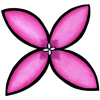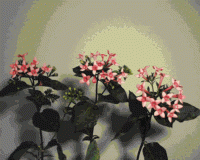Maturity and Quality
Bouvardia flowers are normally harvested with two to three outer flowers open. Purchase when one or two flowers are open on each stem. Avoid flowers that have yellowed foliage, or are showing signs of wilting. If the flowers have been pretreated to prevent the effects of ethylene, there should be little shattering when the flower bunch is shaken.
Grading and Bunching. There are no formal grade standards for Bouvardia, but top-quality flowers will be uniform in maturity and color, free of defects, and have good-quality foliage and long stems. Flowers are normally bunched with 10 stems and sleeved prior to packing.
Postharvest Handling and Storage
Although previous recommendations have been to store Bouvardia at 7-10°F, this species is not chilling sensitive and therefore should be stored, like most temperate cut flowers, at 0-1°C.
Accelerated wilting and abscission result from exposure of Bouvardia flowers to ethylene.
Pretreatments
Because of their ethylene sensitivity, Bouvardia flowers should be pre-treated with 1-MCP or STS. Research has shown STS to be the superior pre-treatment because it protects not only the open flowers but also the developing buds from the effects of ethylene. Treatment for 4 to 24 hours, with water-containing detergents such as Agral LN or Nonoxynol-8.5 prior to dry storage prevents early wilting of the flowers.
Packing
Bouvardia may be packed in horizontal boxes or Proconas.
Special Considerations
Bouvardia exhibits leaf yellowing and is wilt sensitive. In some markets, a special preservative formulation is sold that can reduce leaf yellowing. Re-cut stems underwater and use good sanitation procedures to reduce the frequency of wilted flowers. Postharvest performance differs greatly among the many cultivars marketed.
Disorders
Description
Bouvardia spp. Bouvardia flowers are a relatively recent addition to the florist’s palette. Their bright salmon, red, and white color range and interesting flower form offer interesting design possibilities. The genus is named after Charles Bouvard, 1572-1658, who was a physician to Louis XIII and superintendent of the Royal Gardens in Paris.


